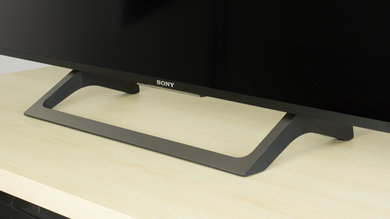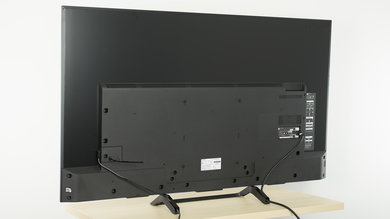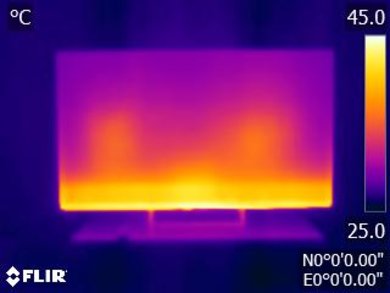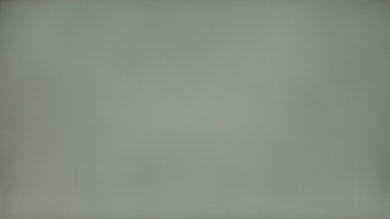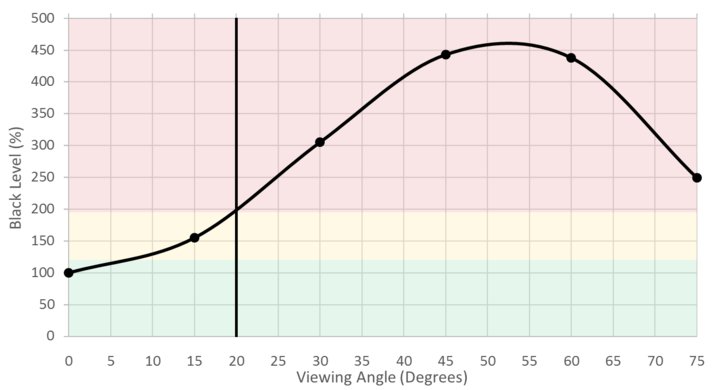The Sony X850E 4k LED TV offers better than average picture quality and excellent motion handling but lacks a handful of high-end features. It does best in darker environments, but it's still capable of getting bright enough to be used in lit rooms without issue. Unfortunately, it isn't the best fit for wider living rooms because of its narrow viewing angle.
Our Verdict
Very good TV overall. The X850E offers a good experience with every usage. Picture quality is good, and it's especially good for fast motion like sports or video games.
-
Deep and uniform blacks
-
Excellent handling of fast motion
-
Can display a wide gamut of colors
-
Image degrades rapidly at an angle
-
Could be brighter for HDR
Decent for movies in a dark room. The contrast ratio is great and blacks are very uniform, but the experience could be enhanced with local dimming.
The X850E is better than average for watching TV shows. It gets sufficiently bright to accommodate brighter living rooms and deals with reflections quite well. It also upscales lower resolution broadcast feeds very well.
Great TV for watching sports. The screen is relatively uniform and without major blotchiness. Motion is excellent, fast sports look fluid and crisp.
The X850E does a terrific job with video games. Input lag is sufficiently low, and it offers a variety of blur reduction features that help keep motion fluid and clear.
Very good TV for watching HDR Movies. Can display a wide range of colors with very little banding in skies. Doesn't get extra bright, however.
Very good HDR gaming TV. Input lag remains low regardless of the input type and the TV's HDR capabilities are good. It doesn't get especially bright though.
Great choice for use as a monitor. Supports a variety of resolutions and has both low input lag and motion blur. Viewing angle isn't great though, so sitting close might cause the edges to darken.
- 7.8 Mixed Usage
- 7.3 Movies
- 7.9 TV Shows
- 7.9 Sports
- 8.2 Video Games
- 7.4 HDR Movies
- 7.9 HDR Gaming
- 8.2 PC Monitor
Changelog
- Updated Jun 12, 2018: A note for Xbox One X and Xbox One S owners: 1080p @ 120 Hz from the Xbox is only supported on this TV when the Xbox's connection type is changed from Auto-detect (Recommended) to HDMI, but unfortunately in this mode 4k and HDR aren't supported.
- Updated Mar 12, 2018: Converted to Test Bench 1.2.
- Updated Dec 11, 2017: Google Assistant has now been added to Android TV on Sony TVs, and it brings a lot of new features to the voice control. The remote score has been increased to reflect the new fuctionality.
- Updated Nov 10, 2017: Retested input lag with the latest firmware (PKG6.2669.0070NAA); there was no significant change.
- Updated Oct 17, 2017: With the latest firmware (PKG6.2669.0070NAA) the judder over 60Hz signals has been fixed.
Check Price
Differences Between Sizes And Variants
We tested the 65" (XBR65X850E).
Update 05/12/2017: Readers have reported that the 75" model has an IPS panel, resulting in a lower native contrast ratio but the image remains more accurate when viewed at an angle.
If someone comes across a different type of panel or if their Sony XBR-65X850E doesn't correspond to our review, let us know and we will update the review. Note that some tests such as the gray uniformity may vary between individual units.
| Size | Model | Alternative Name | UK Model |
| 65" | XBR65X850E | XBR-65X850E | KD-65XE8505 |
| 75" | XBR75X850E | XBR-75X850E | KD-75XE8505 |
Compared To Other TVs

The Sony X850E is a very good TV that offers good value, but some discounted 2016 models will often be a better pick over it. See our recommendations for the best TVs and the best 4k TVs.
The Sony X900E is better than the X850E. The X900E is brighter than the X850E in SDR and HDR, and the 900E has a decent local dimming feature that can dim dark areas of the screen. The Sony X850E has better black uniformity, good for viewing in a dark room, and has a better black frame insertion feature that can improve motion at the cost of some brightness. The 75" X850E uses an IPS panel, which is better for a wide viewing area.
The Sony X850E is slightly better than the Sony X830F. The Sony X850E has marginally better reflection handling when placed in a room with many lights and a slightly better native contrast ratio which is good for movies in a dark room. The Sony X830F has a faster response time that leaves a smaller blur trail in fast action.
The Sony X850E and the Samsung MU8000 have very similar performance. The Samsung MU8000 has better local dimming and can display deeper blacks when watching movies in a dark room, whereas blacks on the Sony X850E are marginally more uniform. The Samsung MU8000 is a bit better for gaming and HDR gaming as it has a bit better input lag even when sent HDR signal. On the other hand, the Sony X850E has somewhat better reflection handling that you'll appreciate if you watch TV shows in brighter rooms.
The Sony X850E is better than the Sony X690E. The Sony X850E has better HDR performance due to better color gamut and better color volume. It can get brighter both in HDR and in SDR and is more suitable for a brighter room. The Sony X850E has better reflection handling, smart features, and motion interpolation support, which is great for those who watch TV shows. On the other hand, the Sony X690E is more responsive as it has lower input lag that makes more suitable for playing video games.
If you've got a bright room with wide seating, then the Sony X850F is a better choice due to its better viewing angles and better reflection handling. But for a dark room with seating directly in-front, the Sony X850E is better. The Sony X850F has marginally better input lag for video games and HDR gaming and is slightly better as a PC monitor. On the other hand, the Sony X850E has a much better contrast ratio and better black uniformity that make it a better choice for movies in a dark room.
Test Results
The central stand supports the TV well and feels stable enough, but the plastic isn't as good as last year's metal stand on the X850D. It has a small footprint, ideal for those with narrower tables, and allows for some basic cable management down the rear tracks.
Footprint of the 65" TV stand: 10.4" x 19.8"
The Sony X850E has a good contrast ratio. At around 4500:1, it is a big step up from the 2016 X850D (IPS TV) which had a contrast ratio of only 1248:1. The higher contrast ratio of the X850E results in deeper blacks which in turn make this TV a good choice for watching movies in a dark room.
Update 05/12/2017: Readers have reported that the 75" model has an IPS panel, so the contrast ratio is expected to be around 1000:1.
The X850E does not have a local dimming feature. Video for reference only.
Good SDR peak brightness, very similar to last year's X850D. The brightness remains relatively constant no matter the content shown, because the TV lacks local dimming and uses very little frame dimming. The real scene brightness is a little less because it is measured near the edge of the screen where the TV is a bit less bright. A plot of brightness over time is found here, and shows that the TV's brightness doesn't decrease over time even when showing a static image.
Decent HDR peak brightness, very similar to the X850D from last year. The TV lacks local dimming and shows very little frame dimming, so the brightness remains relatively constant for all content shown. The screen was brightest in the middle and less bright near the edges, so the real scene brightness is a little less because it was measured near the edge. A plot of HDR peak brightness over time can be found here, and shows that the TV remains bright even after showing a static image for a long time.
The overall gray uniformity of the X850E is good. The uniformity of the 50% gray is a bit worse than the 5%, and while looking at the test picture, you can see that both sides and the top of the screen are darker than the center of the screen. Luckily, there is not much dirty screen effect visible on this TV and sports does not suffer much from it since the center of the screen is pretty much even.
Looking at the test picture of the 5% gray you can see that that the sides are a bit more bright than the rest of the picture, but this is more related to the narrow viewing angle of the X850E than to a uniformity problem.
Poor viewing angle. Colors shift and blacks become gray when the TV is viewed on the side. People sitting to the side of the TV will not have as good picture quality as people sitting directly in front. Last year's X850D has a much better viewing angle because it has an IPS panel.
Update 05/12/2017: Readers have reported that the 75" model has an IPS panel, so expect the viewing angle to be more similar to the X850D we tested in 2016.
The black uniformity of the X850E is excellent, and it is a significant improvement over the 2016 X850D. Looking at the test picture, some really faint clouding can be seen in each corner, but this is really not a problem, and it doesn't show up when watching regular content. When set in a dark room, the X850E really does a good job as displaying dark scenes when watching movie.
Since it does not have local dimming, some clouding may be visible when displaying a bright highlight, but it is not because of native black uniformity problems but more a limitation of the backlight technology used in this TV.
Before calibration, the color accuracy X850E is a bit off. The white balance dE is high but should not be a problem. The color dE is a bit more accurate and should not be a problem even for enthusiast owners. As for the gamma, the X850E tracking is a bit off, but the difference is minor and also should not cause any issues.
Calibration of the X850E is easy and pretty fast to do. The white balance dE was brought down considerably, and the gamma curve flattened to closely track our goal of 2.2. The color dE was also brought down, but could not be brought down further, since, like other Sony TV, there is no color space management.
You can see our recommended settings here.
1080p content such as Blu-rays are upscaled well. The image looks sharp.
1080p is upscaled differently from most TVs. See our Additional Review Notes.
Mediocre color volume. The TV is able to show its wide color gamut at high and mid brightness levels, but it's not as good with dark colors because it can't dim them as well as a TV with local dimming.
The X850E can display our gradient test image without any signs of banding typically seen on 8-bit panel. There are not too many problems that can be noticed, besides some little imperfections in the darker shades of colors. This is fairly good and should not present any problems while watching regular content.
The Sony X850E does not show any signs of image retention like most of TVs using VA panel. Right after the 10 minutes burn-in scene no retention is visible.
We don't expect VA panels to experience permanent image retention, as the VA panel in our long-term test appears immune.
It is possible to enable a strong flicker to clear up motion by setting 'MotionFlow' to 'Custom' and increasing the 'Clearness' slider. This is also possible when in the 'Game' or 'Graphics' picture modes, unlike on the X690E.
The X850E has a 120Hz panel which can interpolate lower frame rate content and produce a strong soap opera effect. To do so, set 'MotionFlow' to 'Custom' and increase the 'Clearness' slider. Adjusting 'Cinemotion' will change the threshold for interpolation. Set it to 'High' for the strongest soap opera effect'. Note that motion interpolation will introduce artifacts on any TV.
This Sony TV is good at displaying content smoothly, without stutter due to low frame rates. This is due to the pixel response time, which smooths the transitions between each frame.
The X850E can play 24p movies from DVD and Blu-ray players and native streaming apps without judder. Movies playing from a 60p/60i source such as a cable/satellite box are also able to play smoothly without judder.
To be able to display movies from 24p source without judder the 'Motionflow' option must be set to 'True Cinema' and 'CineMotion' set to 'high'.
Update 10/17/2017: With the latest firmware (PKG6.2669.0070NAA) the judder over 60Hz signals has been fixed.
The X850E has a native 120Hz panel, but doesn't support any variable refresh rate features such as FreeSync and G-Sync.
Low input lag. When in the game or graphics picture modes the TV has ~33 ms of input lag, which is good enough for most gamers. The ~2 ms difference between 4k and 1080p input lag is negligible.
Update 05/23/2017: The TV has been retested after the update to Android TV 7.0 Nougat, and the input lag is unchanged.
Update 07/18/2017: The TV has been tested with the newest firmware update (PKG6.2648.0065NAA). The input lag remains the same.
Update 09/05/2017: Note that the input lag in the 'Game' picture mode is unaffected by the 'Reality Creation' option, whether set to 'Off’, ‘Auto’ or ‘Manual’ across the range of the ‘Resolution’ slider.
Update 09/20/2017: Tested 1080p @ 120 Hz input lag using our new input lag tool. It is much faster than the 1080p @ 60 Hz input lag, likely due to the TV bypassing some processing when it detects such an unusual signal.
Update 11/10/2017: Retested input lag with the latest firmware (PKG6.2669.0070NAA); there was no significant change.
All the common input resolutions are supported. Chroma 4:4:4 is supported in the game or graphics picture modes. Only HDMI inputs 2 and 3 support 4k @ 60Hz @ chroma 4:4:4 or 4:2:2, and only when 'HDMI Enhanced Format' is enabled.
On a PC the default resolution is 1080p @ 60 Hz but the resolution can easily be changed to 4k. 1080p @ 120 Hz @ 4:4:4 is supported but doesn't appear by default, so a custom resolution is needed.
Update 06/12/2018: A note for Xbox One X and Xbox One S owners: 1080p @ 120 Hz from the Xbox is only supported on this TV when the Xbox's connection type is changed from Auto-detect (Recommended) to HDMI: (Xbox > Settings > Display & sound > Video fidelity & overscan > Display > Connection > HDMI). Unfortunately in this mode 4k, HDR, 50 Hz and 24 Hz aren't possible, so this mode is only recommended when the higher refresh rate of 120 Hz is more important to you than these other features.
Update 06/18/2018: Correction, 24 Hz and 50 Hz are in fact possible with the Xbox's connection type set to HDMI.
On the rear of the TV there is a shared component/composite input which does not require an adapter. There is an additional composite input on the side, but an adapter is not included. Here is an example of the required adapter.
Below average frequency response. Volume gets sufficiently loud, but a steep bass peak leads a boomy sound signature. A slight amount of compression is present at higher volumes as well.
The X850E unfortunately produces a lot of distortion at higher volumes. It remains fairly contained under 80dB, it quickly gets more pronounced past that point.
The TV's main interface doesn't have any ads, but third party apps may contain ads. There is an option in the TV to opt out of personalized advertising for these ads in apps.
The first row on the Home screen shows suggested content. It is possible to disable all sources of suggested content until all that remains is a line saying "No recommendations available at this time". However after all sources of suggested content have been disabled and the TV has been restarted more sources will appear that were not listed before, so the process must be repeated a few times.
The TV comes with a lot of apps already installed such as Netflix, YouTube and Amazon Video. It also has access to the Google Play Store which has a vast library of apps and content.
The remote is rather large and has a lot of buttons. A cluster of buttons around the direction pad serves as the centerpiece of the remote, and ensures that most of the common buttons are within easy reach. The remote has a microphone for voice search, which is activated by pressing the microphone button.
The remote's buttons aren't as easy to press as on the remotes of the X900E and last year's X850D, because each button is a separate chunk of rubber rather than part of one uniform surface.
Update 12/11/2017: Google Assistant has now been added to Android TV on Sony TVs, and it brings a lot of new features to the voice control: commands like 'open Netflix', 'switch to HDMI 1', 'pause video', 'how's the weather' and 'turn off TV' all work well, though commands to change picture settings like 'set the brightness to 20' and 'switch to Game mode' don't work. The remote score has been increased to reflect the new fuctionality.
Update 09/12/2017: Sony has an app called 'Video & TV SideView' that's better than Google's Android TV app in most ways. The data fields and score have been updated to reflect the Sony app.
Update 07/11/2018: Sony's Video & TV SideView remote app has been retested on version 5.5.0. The remote app can now stream video files and can only directly launch apps. The data fields have been updated.
Update 10/12/2018: The remote app can directly launch both apps and inputs, even on version 5.5.0; "Apps Only" was a mistake. The value has been corrected to "Both".
Comments
Sony X850E: Main Discussion
Let us know why you want us to review the product here, or encourage others to vote for this product.


